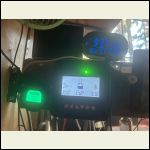| << . 1 . 2 . 3 . >> |
| Author |
Message |
paulz
Member
|
# Posted: 22 Oct 2022 03:00pm
Reply
Mine are 140AH. As I mentioned, I'm only looking to charge to 14.0 or less, just that the amps go up when turning up the Meanwell from 14.2 to 14.6. The batteries, at either setting, still read in the 13s, with no plans to go any higher, just wasted gas and genny time to do so.
|
|
gcrank1
Member
|
# Posted: 22 Oct 2022 03:26pm - Edited by: gcrank1
Reply
That would be like 7Amps endcurrent for yours. Just do keep that eye on and yer good.
Do you have a timer you can run the MW from? I think such could be a good 'safety' doing what you want to do.
Fwiw, Im still shaking off the old LA thinkin' but Im gettin' better 
|
|
paulz
Member
|
# Posted: 24 Oct 2022 09:37pm
Reply
Quoting: gcrank1 Do you have a timer you can run the MW from? I think such could be a good 'safety' doing what you want to do.
Sort of. The little generator I'm using doesn't even hold a gallon of gas.. 
I've been firing it up at 12.9 volts last few days. Out of curiosity I checked the specs on my LFPs. 'Nominal' voltage is 12.8. So what does that mean? Also charge voltage 14.6..
|
|
gcrank1
Member
|
# Posted: 25 Oct 2022 02:25pm
Reply
Well, as we are used to in automotive and motorcycles, 12v is the 'nominal' voltage but we know that a typical 12v battery is closer to 13v and when down to 12v it is basically 'dead'. The 'nominal' thing is an archaic hold-over useful conversationally but not accurate at all.
Then we have the translation thing, both in understanding and in literal. Imo that 'rating' you quote would be better to me if it dropped the 'nominal' since they are spec'ing a specific voltage.
We know from (ref. Steve_S again) prev posts that LFP has its real flat 'power window' from pretty much 13.0 to 13.4. With LFP Im more inclined to be Specific, it is very important.
|
|
paulz
Member
|
# Posted: 25 Oct 2022 03:26pm
Reply
I guess that 12.8 nominal was wishful thinking.  My bank has been down to 12.9 every morning lately, even after some generator charging. Seems to be dropping from 13.2 rather quickly, more than it used to. Soon as I get this cable reconfig done I'm going to give it a serious charge, get it up towards 14 and see what happens. Could be my old batteries are starting to go but on the other hand the solar charging is nowhere near what it was a month or two ago. My bank has been down to 12.9 every morning lately, even after some generator charging. Seems to be dropping from 13.2 rather quickly, more than it used to. Soon as I get this cable reconfig done I'm going to give it a serious charge, get it up towards 14 and see what happens. Could be my old batteries are starting to go but on the other hand the solar charging is nowhere near what it was a month or two ago.
|
|
gcrank1
Member
|
# Posted: 25 Oct 2022 04:29pm
Reply
What is your bat's LVD?
Since LFP doesnt need to be fully charged asap maybe it doesnt matter if your 'window of use' varies a bit in the level of charge profile as long as it isnt tripping the LVD?
I do agree that a solid 'top charge' may be of use, just sos ya knows, but the bat will still always settle where it wants to be. The question to me is it going to settle at the bottom, mid or top of 'a tenth'; ie, (example only), 13.31, 13.35, 13.95 which may translate into several hours of usage.
|
|
paulz
Member
|
# Posted: 25 Oct 2022 05:14pm - Edited by: paulz
Reply
LVD is 10 volts for the internal BMS, as show in the pic above, but I have an external Victron set at 12 or 12.5, I'll have to check that, and write it down.
I'm in the city today getting glasses (to go with the hearing aids..) so it has all day to charge without any load, and it's a sunny day. Should be looking better tomorrow. I, on the other hand, will look like a nerd.
|
|
gcrank1
Member
|
# Posted: 25 Oct 2022 07:09pm
Reply
According to Steve, iirc, what we want to find is the point that the LFP starts to 'fall off the cliff' and use that as our bottom end.
I dont have any of those programmable devices to set with the bat to get them to sorta accurately talk together, and that not being matched seems to be common in misreading of where the LFP is 'at'.
I have kept my eye on during a steady discharge use to find where the 'tenths' start ticking by faster, telling me that the slide is on. As long as I know where that is, even if my voltmeter isnt truly accurate, is fine functionally.
|
|
|
Steve_S
Member
|
# Posted: 26 Oct 2022 08:49am
Reply
With LFP the cliff falls to bottom really starts around 2.800-2.850 11.2V-11.4. When a heavier load hist at those voltages, the voltage sag is greater and may trigger LVD.
|
|
paulz
Member
|
# Posted: 27 Oct 2022 05:37pm
Reply
Whew, big reconfig today.
Replaced the doubled up 6awg inverter cables I put in after you guys figured out that's why my inverter was shutting off, with 0awg.
Installed two Meanwell's in parallel, inside instead of outside, also with 0awg. These big cables are a pain. Newbies, go 24 or 48v, smaller cables.
Mounted the Victron LVD and main CB on the wall, previously unmounted. New main power cable, 2/0. Cleaned up some other wiring.
Got all done, everything works. Fired up the genny, at 13.1v I got a 50A charge, should be even higher with a lower bank.
Enough brain work, tomorrow I'm going to cut firewood.
|
|
gcrank1
Member
|
# Posted: 27 Oct 2022 10:55pm
Reply
That sounds promising!
I eagerly await your over-time report 
|
|
paulz
Member
|
# Posted: 28 Oct 2022 09:15am - Edited by: paulz
Reply
Another thing occurred to me last night.. As you've probably noticed, the Meanwells spark when connecting to the battery, as they charge their internal capacitors. I think it was Traveler who mentioned it may shorten the life of the power supply to have them permanently connected, like I did yesterday. SCCs and inverters do this too though, and are of course permanently wire in.
I did a little reading on switched power supplies and as usual with electronics came away more confused. There is also something called Leakage Current, I think that's a drain on the batteries. The cure, as discussed on this DIY electric car forum, is a diode, or a switch, which cures the capacitors being on all the time issue.
https://www.diyelectriccar.com/threads/using-switching-power-supplies-as-charger-wiri ng-options.83420/
To make it even more confusing, apparently there are different styles of switched power supplies, some good for battery charging, some not, and I don't know where our Meanwells fall in. Here's the page on that.
https://forum.digikey.com/t/using-a-switching-power-supply-for-battery-charging/4281
Here's the data sheet on our MWs
https://www.meanwell.com/productPdf.aspx?i=469#1
|
|
gcrank1
Member
|
# Posted: 28 Oct 2022 11:01am
Reply
Iirc there is more than a little info over at diysolarforum.com on power supplies as chargers, the W in specific And 'pre-charging capacitors'.
|
|
paulz
Member
|
# Posted: 28 Oct 2022 12:06pm
Reply
Yeah I read about pre-charging, I think it just avoids the spark when installing. Or maybe softens in the in rush current, if that is a problem.
|
|
gcrank1
Member
|
# Posted: 28 Oct 2022 02:22pm
Reply
It depending upon the size of the spark you get with a particular device, big spark, more need to soften it.
You may have the 'right size' resister in your bins, otherwise they arent expensive online, but an incandescent Edison base light bulb in a socket with a couple 'gator clips to wired inline on either the + or - lead (NOT across + to - !) will do it.
|
|
paulz
Member
|
# Posted: 2 Nov 2022 11:09am
Reply
Last night, throwing caution to the wind and after a rainy low solar day, I decided to forgo any generator charging and went to sleep with the batts at 12.9. This morning down to 12.8, and even 12.7 after turning on lights and chargers. But no signs of trouble. Fired up the genny, 50A going in, same as when I charged from 13.1. So I guess that's all the charge I'm going to get out of this setup, which is OK. Long as I brew coffee off the genny and limit TV we should be OK for the winter.
|
|
gcrank1
Member
|
# Posted: 2 Nov 2022 12:27pm
Reply
Ive been swapping out bats at about 13.0-13.1 all season but thinking now that is premature.
Just yesterday brought home the cabin lfp bat that we have had there for about the past month with No cabin charging, it is at 13.1.
Hooking up the MW set at 13.7 my amps are only at 10 (granted, my ammeter is crude, but I have seen it go much higher if I crank up the volts to 14.4).
Im suspecting Im not down far enough to have even brought it home.
|
|
paulz
Member
|
# Posted: 21 Oct 2023 12:02pm
Reply
Just found this year old thread. Still need to study it again, but..
Been wondering how much life is left in my 4-140AH Valence LFP (they are a decade old and have daily use and charging). Lately they are down to 12.9 in the morning from 13.1 or 2 after running the fridge and modem all night (about 4 amps for both) but I see from this thread that was the case a year ago (I was away for a year). They have never been any lower and the built in BMSs have never cut them off. So I guess I’m OK for awhile. They do seem to take awhile to get back to 13.2, even with 80A charging off the two Meanwells.
I’d like to try a measurable load test, remeasure the MW outputs and solar (I get 20-40A charge for a couple hours a day usually) but also wanted to bump this thread for further use.
|
|
FishHog
Member
|
# Posted: 21 Oct 2023 01:24pm
Reply
Quoting: paulz Been wondering how much life is left in my 4-140AH Valence LFP (they are a decade old and have daily use and charging)
buy a battery capacity tester, like this. Even cheaper ones on aliexpress, and test the capacity of each battery.
https://www.amazon.com/Maxmartt-Adjustable-Constant-Electronic-Capacity/dp/B084GP95QF /ref=sr_1_3?crid=3IXZKAUI1SGV3&keywords=Electronic+Load+Tester+150W+20A+Resistor+Adju stable+Current+Battery+Capacity+Tester&qid=1697908946&sprefix=electronic+load+tester+ 150w+20a+resistor+adjustable+current+battery+capacity+tester%2Caps%2C637&sr=8-3
|
|
Steve_S
Member
|
# Posted: 21 Oct 2023 01:51pm
Reply
I have one of the testers shown above, as well as the cooler tower one (slightly different), they work ok and are reasonably close.
If I recall, you have all 4 batteries setup IN Parallel with a common DC Bus using busbars. If you were to install a Smart Shunt between the batteries & the SCC / inverter, you could keep a pretty accurate eye on the capacity, plus you could watch the amperage / voltage coming in from your solar as well. There are many out there and several have either an LCD display or just use a Phone APP to program and monitor.
You can also use a Kill-O-Watt meter from full charge to empty with a fixed draw (little electric heater) to see what the real End Capacity after losses etc... Some of teh Kill-O-Watt variants can store teh data and more... there are a few different versions and they cost similar to the above tester posted.
|
|
paulz
Member
|
# Posted: 23 Oct 2023 08:32am
Reply
Yes my 4 batts are in parallel. I do have this old car battery load tester, if I disconnect and test each battery would it harm the LFPs?
|
|
Steve_S
Member
|
# Posted: 23 Oct 2023 08:36am
Reply
Honestly, I dunno about Car Battery testers being used against LFP, personally I wouldn't.
|
|
gcrank1
Member
|
# Posted: 23 Oct 2023 09:42am - Edited by: gcrank1
Reply
Think Id top charge the whole bank and note it, then take each out of the system one by one (still leaving you 3 to run on), let sit a good bit to settle and note the charge.
Then discharge with a known load like the space heater to the LVD and note the low voltage and the number of hours run time you got.
May have to jumper to the bank to re-activate the BMS to take a charge? Then charge with the Meanwell set at 13.8 (for a 12v battery) until the charge amps drop to almost nothing, that seems to charge Mine well up Very Nicely though after a few hours sitting they settle to 13.3. Im quite sure it was Steve that recommended that setting.
Do this with each one, completing the notes to compare (you do have the bats numbered, right?).
Not sure, but if one LA in a bank is substandard the bank is pulled down to that level; is LFP the same?
Anyway, this process should 'top balance' your bank and give you a good idea of each bat's health.
Iirc there is an acceptable little diff at top of each for completing the bank. If any are off by quite a bit it is suspect.
I havent 'built' a battery but studied it out some, this process for parallel bats seems to me to be very like the top balancing/sorting out the individual cells inside an LFP battery before assembling. We want to match up the 'power components' to comfortably work with each other.
|
|
Steve_S
Member
|
# Posted: 23 Oct 2023 10:21am
Reply
Unlike Lead, you can have different capacity battery packs in Parallel without major consequences thanks to the BMS' controlling LVD and with LFP having such a flat voltage curve.
Consider that in my bank, I have 2x174AH, 1x105AH & now 4x280AH, all work happily & transparently with each other.
|
|
gcrank1
Member
|
# Posted: 23 Oct 2023 10:36am
Reply
I get it that with LFP we can mix various AH bats of the same nominal voltage.
But if one bat in a 4x'12v' bank keeps wanting to settle at, say, 13.0 and the other 3 go 13.2 does that 13.0 mess up the usable hours because it hits its LVD sooner (just like a poor/bad cell in a bat)?
|
|
paulz
Member
|
# Posted: 23 Oct 2023 12:46pm
Reply
Ok, won’t try the car load tester. Probably another of my bad ideas. Thanks.
I do have gauges by my bed that give volts, amps going either way, etc. Also have the Valence software on my laptop that hooks direct to the batts. All four read very close to this one all the time, never more than.002 variance. Curiously the cell voltage minimum is always low, in the red, even though they show 13.3 volts (just ran the charger) and 99% charged.
IMG_1625.jpeg
| 
IMG_1626.jpeg
|  |  |
|
|
gcrank1
Member
|
# Posted: 23 Oct 2023 01:18pm
Reply
What matters is where they each settle out with no load. I think you have to check each unhooked from the bank or you get the bank high read.
|
|
paulz
Member
|
# Posted: 23 Oct 2023 02:00pm
Reply
If you look at these 4 images, in the ‘module id box (blue highlight) you will see batteries 1-4, all different cell voltages.
All power off. The negative current number is what’s coming in from the solar.
IMG_1631.jpeg
| 
IMG_1632.jpeg
| 
IMG_1633.jpeg
| 
IMG_1634.jpeg
|
|
|
gcrank1
Member
|
# Posted: 23 Oct 2023 03:24pm
Reply
Way over my head and pay grade, Paul, Im just another old knuckle buster/finger masher; lol.
Wasnt long ago I couldnt even spell LFP....
|
|
Steve_S
Member
|
# Posted: 23 Oct 2023 07:48pm
Reply
Quoting: gcrank1 But if one bat in a 4x'12v' bank keeps wanting to settle at, say, 13.0 and the other 3 go 13.2 does that 13.0 mess up the usable hours because it hits its LVD sooner (just like a poor/bad cell in a bat)?
Yes, if 4 12V are in Series (for 48V) and you have 1 low battery in that series, then that series will use the lowest common denominator as it's throttle. Not so in parallel as the BMS will control that.
Paul, the 4 batteries are actually pretty darn good for being 12 years old. 99.2% SOC with cells at 3.30# is pretty close too, as 3.400 is 100% SOC. I do not see anything there that raises any flags at all.
These do have PASSIVE Balancing, which means they will burn off energy from Hi Voltage cells (will not transfer it to lo cells). Passive is terribly slow BUT with Matched Cells it works reasonably well and all the valence batteries have Matched Cells. It is required due to the nature of what these are intended for, hospitals cannot & do not screw about with that stuff.
|
|
| << . 1 . 2 . 3 . >> |

